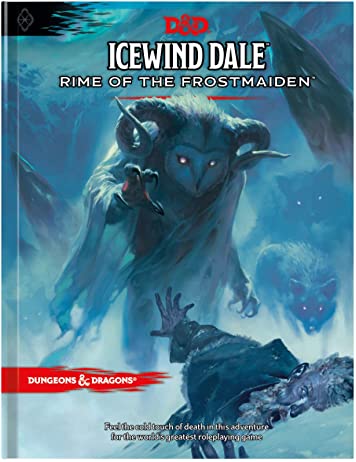Icewind Dale: Rime of the Frostmaiden is out!
And immediately, the main thing some of my good friends have focused on is the difficulty of one of the opening quests.
This quest pits the characters – quite likely four level 1 adventurers – against a Challenge 3 opponent. Usually, this would outrage me. I have a low tolerance for narratively-required encounters where there is a strong chance where several characters will die.
However, it does not bother me as much for this quest. Why? Because it takes place in a sandbox environment. (It is also an encounter that some parties will easily handle because they are smart!)
Linear and Sandbox
We tend to evaluate adventures on how linearly they play. It is not, by any means, the be-all-and-end-all of adventure evaluation, but it does help when, as a DM, you plan what can happen in a session. In a linear adventure, one thing follows another, and the path of the characters is entirely predictable. In a sandbox adventure – you could also call it “open-world” – then characters are not locked into a strict progression of events and can affect the order of events.
Adventures can contain elements of both. Some sections can be quite open with a lot of actions available to the players. Other sections can be closed and very linear. The overall play of an adventure might be linear, but individual sections allow a lot of variance.
Not all players enjoy both types. I have DMed players who work best in an open world system, and players who want a linear adventure more.
Even within the realm of “open-world” or “sandbox”, there are variants. With published adventures – and, indeed, many campaigns – the DM creates several rumours and plot hooks and allows the players to choose which one to pursue first. Contrasts this with purely player-directed play, where the players initiate the quests themselves. However, in my experience, that last is quite rare, and I am not the person to talk about how it works!
Icewind Dale: Rime of the Frostmaiden begins with that idea of a sandbox with many plot hooks and quests, with more quests opening up as the characters visit various locations. So, it sits in the realm of a directed sandbox.
Surviving the Impossible
One of the best ways of surviving a difficult task is not to undertake it. The DM can present the mission with warning flags, or the players can learn of them as they investigate.
That is something you can achieve. However, a party can also survive a difficult encounter purely through smart play, especially when they can make some choice as to terrain and tactics.
If you ever want to see a party take down a high-threat challenge with ease, watch them in the wilderness where they can attack with ranged weapons and spells against opponents who do not have ranged weapons themselves. It is brutal. Possibly one of the biggest mistakes I have seen new players make is not having a ranged weapon or spell. Bows and crossbows can make an encounter significantly easier. Use them!
Finally, there are situations where you only realised how outmatched you are after combat is joined. Learn how to run away!
If you fail an encounter, this is where the difference between linear and sandbox becomes very apparent. In linear, you are stuck. You fail. There is no way past. In an open world, you get to try a different mission and come back when you have better equipped to take on the challenge.
The point is to have other options available: if you cannot succeed at one task, is there another you can attempt?
Good Narrative Design
If you are getting the idea here that the best way of dealing with potentially overpowered threats is to present options, you are right.
In its earliest, basic form, Dungeons & Dragons saw the players delving into the dungeon and selecting rooms to explore. Challenges became more dangerous the deeper you got into the underworld, but even a level one encounter could be too deadly. In those cases, you retreated and tried again.
However, the rise of published adventures saw more structured, narrative storylines. These adventures did vary wildly in how linear they were, just like the current ones do.
It is not a mistake to present encounters that characters must face, but please consider failure states. I have noted this before, most notably in Descent into Avernus. What happens if the players fail?
Rime of the Frostmaiden continues. You can try another mission. You can learn from the experience and try again with better tactics. But it is better if the players know they have other options. If the DM only presents one quest and nothing else, then problems ensue.
When Characters Die
One note: Let your players know when you start a campaign that it is okay if they fail. That some of their characters may die, but they can keep playing.
Do not wait hours and hours if a character dies to introduce a new PC. Get them into the action with the next encounter. Make it happen in any way you can. Players are there to play, not to watch others having fun! (I am ignoring the players who most enjoy other players having fun. They do exist).
These days, I always allow characters to retreat from combat when they realise it is the best option. Reward smart play, but do not be afraid to have consequences of poor decisions or bad luck.
I am okay with an opening challenge that may see one or two characters die. It sets the stakes for the rest of the adventure. I am not too fond of it when an encounter may see everyone die (fireballs against level 2 parties) or allows no recovery if the party fails.
If you can identify these challenging encounters in advance, it makes preparation a lot easier!

